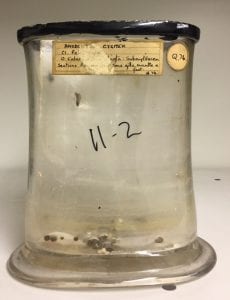Specimen of the Week 310: The Gross, the Bad and the Ugly
By Tannis Davidson, on 29 September 2017
Ah, Specimen of the Week. The weekly showcasing of specimens from the Grant Museum. Over the years this blog has featured the furry, the fluid, the skeletal, the dangerous, the poisonous, the new, the old, the damaged, the conserved, the plentiful, the endangered, the extant, the extinct, the big, the beautiful, the tiny, the hideous, the lost and the found.
The specimens are meticulously selected each week to offer a bit of fun, insight and enjoyment to the reader. This week however, is a somber affair. Rather than a celebration of life, this week’s Specimen of the Week is an obituary. Say goodbye to…
** The Gross, the Bad and the Ugly**
London, Bloomsbury – 35 preserved specimens from the collection of the Grant Museum of Zoology at UCL, following a long deterioration.
The specimens, also known as ‘the Disintegrated, the Toxic and the Mouldy’, are survived by their former shelf-mates and fellow spirit specimens in the Grant Museum Wet Store, part of the 68,000 specimen-kin which make up the museum’s collection; museum staff; conservators (providers of palliative care); and many students and researchers who will deeply mourn the lost opportunity to study these specimens.
Born and collected in various exotic locales such as Sri Lanka, Naples and Plymouth, the specimens had been in the collection since at least (according to the sparse documentation) 1940.
In their early years, they were undoubtedly excellent representations of their respective species – collected in order to teach what would be generations of UCL students comparative anatomy. In life, and in early death, they were lampreys, lizards, lungfish, catfish, cuttlefish, clams, Indian toads, clawed toads, tree frogs.
Some were later transformed from the whole to the part of the animal – prepared by students in the laboratory or prepared for the students to study a particular anatomical feature. Their legacy of teaching is evidenced in the detailed illustrations of the specimens in dozens of student lab notebooks in the Museum archive.
Following the years of productive use, the ravages of time (and preservation) began to take a toll. Poorly sealed lids, inappropriate containers, spirit evaporation and/or changing preservative percentages would have contributed to specimen desiccation or mould growth. Some of the specimens were in hazardous spirits– formalin, formic acid or (worse) unknown fluid and had become indiscernible through the murky sludge now contained in their jars:
Eventually, difficult decisions needed to be made. Consultants and carers unanimously agreed it best to end the suffering of these 35 specimens and allow them to pass with dignity. Their final journey was a stomach-churning moving one involving their removal from their glass coffins of ‘not-to-be-the-final-place-of-rest’ to the eventual hazardous waste incineration buckets. The jars of several of the departed will be donated to specimens in need.
A memorial service was held prior to the final journey to the incineration facility. May they rest in peace.
Tannis Davidson is the Curator at the Grant Museum of Zoology
 Close
Close









